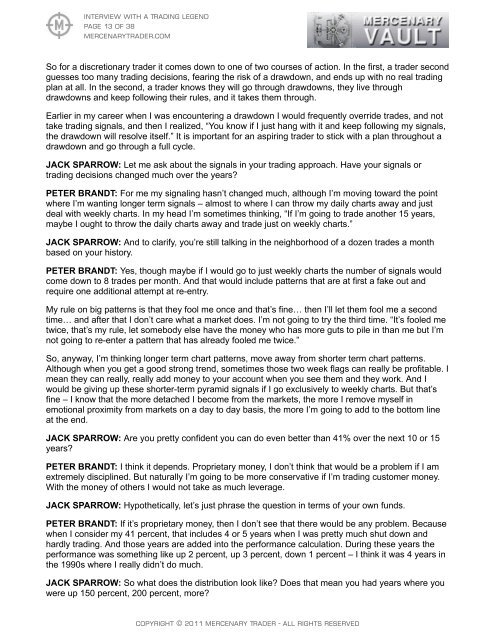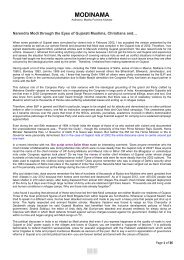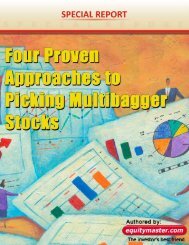Interview With a Trading Legend - Mercenary Trader
Interview With a Trading Legend - Mercenary Trader
Interview With a Trading Legend - Mercenary Trader
You also want an ePaper? Increase the reach of your titles
YUMPU automatically turns print PDFs into web optimized ePapers that Google loves.
<strong>Interview</strong> <strong>With</strong> a <strong>Trading</strong> <strong>Legend</strong><br />
Page 13 of 38<br />
mercenarytrader.com<br />
So for a discretionary trader it comes down to one of two courses of action. In the first, a trader second<br />
guesses too many trading decisions, fearing the risk of a drawdown, and ends up with no real trading<br />
plan at all. In the second, a trader knows they will go through drawdowns, they live through<br />
drawdowns and keep following their rules, and it takes them through.<br />
Earlier in my career when I was encountering a drawdown I would frequently override trades, and not<br />
take trading signals, and then I realized, “You know if I just hang with it and keep following my signals,<br />
the drawdown will resolve itself.” It is important for an aspiring trader to stick with a plan throughout a<br />
drawdown and go through a full cycle.<br />
JACK SPARROW: Let me ask about the signals in your trading approach. Have your signals or<br />
trading decisions changed much over the years?<br />
PETER BRANDT: For me my signaling hasn’t changed much, although I’m moving toward the point<br />
where I’m wanting longer term signals – almost to where I can throw my daily charts away and just<br />
deal with weekly charts. In my head I’m sometimes thinking, “If I’m going to trade another 15 years,<br />
maybe I ought to throw the daily charts away and trade just on weekly charts.”<br />
JACK SPARROW: And to clarify, you’re still talking in the neighborhood of a dozen trades a month<br />
based on your history.<br />
PETER BRANDT: Yes, though maybe if I would go to just weekly charts the number of signals would<br />
come down to 8 trades per month. And that would include patterns that are at first a fake out and<br />
require one additional attempt at re-entry.<br />
My rule on big patterns is that they fool me once and that’s fine… then I’ll let them fool me a second<br />
time… and after that I don’t care what a market does. I’m not going to try the third time. “It’s fooled me<br />
twice, that’s my rule, let somebody else have the money who has more guts to pile in than me but I’m<br />
not going to re-enter a pattern that has already fooled me twice.”<br />
So, anyway, I’m thinking longer term chart patterns, move away from shorter term chart patterns.<br />
Although when you get a good strong trend, sometimes those two week flags can really be profitable. I<br />
mean they can really, really add money to your account when you see them and they work. And I<br />
would be giving up these shorter-term pyramid signals if I go exclusively to weekly charts. But that’s<br />
fine – I know that the more detached I become from the markets, the more I remove myself in<br />
emotional proximity from markets on a day to day basis, the more I’m going to add to the bottom line<br />
at the end.<br />
JACK SPARROW: Are you pretty confident you can do even better than 41% over the next 10 or 15<br />
years?<br />
PETER BRANDT: I think it depends. Proprietary money, I don’t think that would be a problem if I am<br />
extremely disciplined. But naturally I’m going to be more conservative if I’m trading customer money.<br />
<strong>With</strong> the money of others I would not take as much leverage.<br />
JACK SPARROW: Hypothetically, let’s just phrase the question in terms of your own funds.<br />
PETER BRANDT: If it’s proprietary money, then I don’t see that there would be any problem. Because<br />
when I consider my 41 percent, that includes 4 or 5 years when I was pretty much shut down and<br />
hardly trading. And those years are added into the performance calculation. During these years the<br />
performance was something like up 2 percent, up 3 percent, down 1 percent – I think it was 4 years in<br />
the 1990s where I really didn’t do much.<br />
JACK SPARROW: So what does the distribution look like? Does that mean you had years where you<br />
were up 150 percent, 200 percent, more?<br />
Copyright © 2011 <strong>Mercenary</strong> <strong>Trader</strong> - All Rights Reserved
















